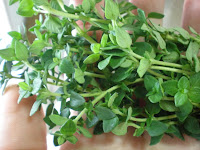Genus of Aromatic Herbs
 Thyme is a widely used culinary herb. There are several varieties, but the most popular is common thyme. The common name is Thymus, a genus of aromatic herbs or shrubby plants of the Mint Family, long cultivated and valued as both ornamentals and sweet herbs. It is a small, perennial shrub, native to the Mediterranean. They have small lavender or pink flowers.
Thyme is a widely used culinary herb. There are several varieties, but the most popular is common thyme. The common name is Thymus, a genus of aromatic herbs or shrubby plants of the Mint Family, long cultivated and valued as both ornamentals and sweet herbs. It is a small, perennial shrub, native to the Mediterranean. They have small lavender or pink flowers.
 Thyme is a widely used culinary herb. There are several varieties, but the most popular is common thyme. The common name is Thymus, a genus of aromatic herbs or shrubby plants of the Mint Family, long cultivated and valued as both ornamentals and sweet herbs. It is a small, perennial shrub, native to the Mediterranean. They have small lavender or pink flowers.
Thyme is a widely used culinary herb. There are several varieties, but the most popular is common thyme. The common name is Thymus, a genus of aromatic herbs or shrubby plants of the Mint Family, long cultivated and valued as both ornamentals and sweet herbs. It is a small, perennial shrub, native to the Mediterranean. They have small lavender or pink flowers.
We find this fragrant herb in all sorts of recipes from meats and vegetables to sauces and breads. Thyme is considered “necessary” in clam chowder, bouquet garni, and herbs de Provence. In the European Middle Ages, the herb was placed beneath pillows to aid sleep and ward off nightmares.
Thyme herb is an easy plant to grow in a pot. It is very hardy and will grow under most conditions. A sunny location is best and good drainage is vital as thyme is somewhat susceptible to root rot. Regular pruning promotes growth so as you take cuttings for the kitchen consider shaping the plant as you go.
Culture
- Seed Spacing 4 to 5 seeds per inch at 1/8" depth
- Seed Germination 8 to 20 days.
- Plant Spacing Thyme plants should be spaced 18 to 24 inches (45 - 60cm) apart.
- Soil Requirements Light, well-draining, poor to fertile.
- Sun & Lighting Thyme grown outdoors prefers full sun.
- Water Requirements Average water needs. Water on a regular schedule, do not overwater.
 Thyme herb in its fresh form adds flavour to a recipe as well as making a lovely garnish. Thyme is slow to release its flavors so it is usually added early in the cooking process. Before adding fresh thyme to a dish, the greyish-green leaves should be stripped from the woody stem. These stems smoke pleasantly when tossed onto the coals while barbecuing.
Thyme herb in its fresh form adds flavour to a recipe as well as making a lovely garnish. Thyme is slow to release its flavors so it is usually added early in the cooking process. Before adding fresh thyme to a dish, the greyish-green leaves should be stripped from the woody stem. These stems smoke pleasantly when tossed onto the coals while barbecuing. Related Articles:
No comments:
Post a Comment